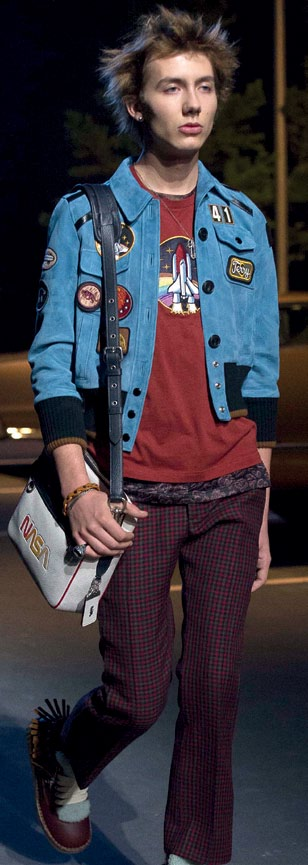Coach celebrated turning 75 with a nostalgic pre-fall show in the ciry where it all began: New York.


Coach celebrated turning 75 with a nostalgic pre-fall show in the ciry where it all began: New York.


The expansive, sunlit hall of Coach’s global headquarters seems unassumingly serene, despite it being the morning of the fashion show to celebrate the American heritage brand’s 75th anniversary. The scene before me seems right out of a well-rehearsed play. Binx Walton, Sora Choi and Lexi Boling, some of today’s coolest clotheshorses, are enjoying their breakfast while waiting for their turn at fittings. Assistants are pacing around in the distance, rushing to coordinate interviews for the international media who have flown into town for the celebrations. The man at the centre of it all, Stuart Vevers, is lounging on a sofa with Hudson Yards’ skyscrapers in the background, facing rows upon rows of accessories and racks of clothes.
Vevers has made fundamental changes to Coach since the beginning of his stewardship. Taking the brand out of the confines of Manhattan, where the brand started as a family-run workshop in 1941, he has infused a mix of prairie, rock ’n’ roll and quirkiness (hello, dinosaurs and rockets!) to Coach’s expertise in leather and craftsmanship.The significant shift in the brand’s target audience can also be accredited as part of Vevers’ success. Members of the Instagram generation are now slinging the brand’s beloved Dinky and toting the Rogue with ease, placing Coach firmly in the youth vernacular. The recent appointment of Selena Gomez into the House’s coterie of millennial muses and collaborators serves to further sweeten the deal. The result? Coach’s cool currency is on the up and up, with a downtown-meets-“Rebel, Rebel” vibe. The numbers don’t lie: Earlier this year, Coach shares climbed 23 percent for the year-to-date period and they are up four percent for the past 12 months. As the brand enters a new period of growth—Coach is planning to acquire Kate Spade for US$2.44 billion at the time of print—I spoke to Vevers before the big show began to get the Englishman’s thoughts on his vision for the brand.
We met right after your first season at Coach. Since then, you seem to have found your way of approaching the brand.
When I first started at Coach, I glanced at its archive and heritage. Since then, I have started looking forward so I can really establish who the Coach girl and guy should be. But the thing I care about the most, though, is what the next generation is interested in and what motivates them. For me, that’s a way to challenge the meaning of luxury and fashion; that’s why it’s important to look forward. Having said that, I definitely have a sense of nostalgia for the symbols of American style and culture. They influence my work and I am definitely putting that into context so that they’re relevant for today.
How have you tackled Coach’s history in your approach to the brand?
I want to put the things that people already knew, and loved, of Coach and fit them more into modern life, such as the turn-lock closure, hangtag, horse and carriage. I really enforce them as strong symbols at the House—the tea rose and prairie florals have now become recurring prints within my work. On top of that, we’ve reintroduced glove-tanned leather, a part of Coach history that wasn’t in use when I arrived. Meanwhile, Rexy, the Coach Dino, has become a mascot of the new Coach. I think it’s important to re-energise the existing symbols of the House, but I’ve always thought that part of my role is to create brand new things from scratch. And I love that Rexy the Dino is totally random and doesn’t come from the heritage. People always come to me and ask, “Why a dino?” And I always say, “Because I like it.” It’s really that simple.
There seems to be a certain kind of purity and authenticity in your approach to creating a collection. In your opinion, how important is a designer’s instinct?
Honestly, it’s all about instinct. At the end of the day, I am, first and foremost, a designer, and I always trust my gut instinct and emotions; that’s how I start. Often the ideas that spark an emotion in me, the things that make me excited, or maybe even nervous because I’m not sure if I’ve pushed things too far, in my experience, those are what most of our customers respond to. They feel that same emotion and I think that’s important.


Looking back to how you started at Coach, is there anything you’d like to do differently?
I feel so fortunate with that first collection. It set the vision that I have for the brand. It was my first instinct to present something that could be believable as the ready-to-wear and fashion for Coach, something that the brand hasn’t strongly addressed previously. And people embraced it; they believed in it. And that gave me the permission to follow that path and it gave me the confidence to push that idea further. I wouldn’t change anything because of that. Of course, as we evolve, the vision has become clearer and stronger.
Was it a conscious decision for you to take the Coach girl out of Manhattan?
It wasn’t conscious. Whilst I think New York City is home for the brand, and it is a very important source of inspiration, America and American style are also important and they resonate so well today. From the sweatshirt to sneakers to backpacks, all of these come from an authentic place of American ease and functional style. That effortlessness is what I’m very excited to explore.
So where is the Coach girl right now? Is she on a journey?
I’ve never felt, as a designer, that the journey will ever be complete. I’m always exploring different aspects of the character of the girl, by either revisiting or reinforcing things. I have always felt that consistency is very important to my work at Coach. It was reset a bit and was a big change; and I need to give people time to understand the characteristic of the girl. I needed the chance to be able to tell a story.
How about the Coach boy? What is he to the Coach girl?
They’re definitely in the same gang [chuckles]. They have much more in common than they have differences. One of the things I love to do is make them swap clothes. The Coach girl always has a colourful and feminine take on boys’ clothes. To me, that feels modern, because that’s how I see my girlfriends dress. And this season is where, for the first time, we have things in reverse. It just seems more fluid.
In your opinion, what’s the most American thing about Coach?
It’s the inclusivity. It’s that idea that Coach celebrates people’s differences, diversity and freedom, which makes Coach a real and authentic House. I love that Coach is grounded in reality and doesn’t project a fantasy, jet-set lifestyle. For me, that’s the modern way to interpret luxury. To me, inclusivity is also to celebrate togetherness and optimism.
How important is youth culture in the whole mix?
I find an interesting parallel when I look at Coach’s history. It started in New York City in 1941, literally when the term “cool” was starting to be used in America. It’s fascinating that that was the time of the birth of cool and youth culture. So I just kind of trace that part of the Coach story and heritage alongside the explosion of creativity, youth culture and counterculture. It’s about the mix of romantics, rebels and dreamers who have inspired me for all the work I’ve done at Coach.
So what’s next for Coach?
Without giving too much away, there’s something optimistic about this collection. There’s still the tension that the Coach girl and guy have, but there’s a big celebration enveloping it. Yes it’s a pre-fall and fall collection presentation, but there’s more than that. The brand has made progress that I’m really proud of; of the shift we’ve made about the perception of the brand. We have moved into our new headquarters, we just opened our biggest store in the world on Fifth Avenue in New York and it’s our 75th anniversary, so I wanted this show to be a big celebration of the moment we live in. When I see all the important American values, that togetherness and optimism, that’s what I’m celebrating.























